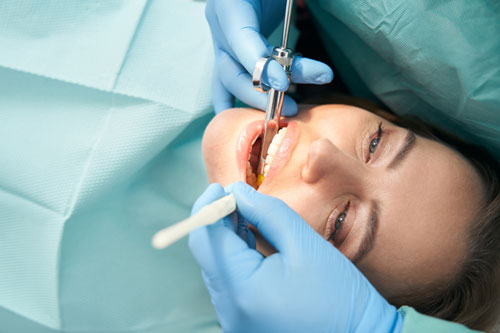What is gum disease treatment?
- Gum disease treatment encompasses a wide range of dental procedures. Healthcare providers use these procedures to reduce infection in your mouth and rebuild tissues damaged by periodontal (gum) disease. Periodontists (gum specialists) usually perform these procedures. But general dentists sometimes treat milder forms of gum disease.
- Gum disease occurs when plaque and tartar build up on your teeth surfaces. Your gums react to the bacteria in these irritants and become red, swollen and tender. Your gums may also bleed when you brush or floss.
- The sooner you treat gum disease, the better chance you have for long-lasting oral health. At its earliest stage (gingivitis), gum disease is reversible. But the later stages (periodontitis) damage your gums and underlying bone. This results in gaps — or periodontal pockets — around your teeth, leading to further infection, loose teeth and even tooth loss

.How common is gum disease treatment?
Gum disease treatments are among the most commonly performed dental procedures. In the U.S., almost half of all adults aged 30 or over have some form of gum disease. About 9% of adults in the U.S. need advanced gum disease treatment.
PROCEDURE DETAILS
Nonsurgical vs. surgical treatments for gum disease: What are my options?
Whether you need surgical or nonsurgical gum disease treatment depends on several factors, including:
- The stage of gum disease.
- Your existing oral health.
- Your existing overall health.
- Your ability to follow post-treatment oral hygiene instructions.
There are a number of nonsurgical and surgical gum disease treatment options available. In addition, many periodontists offer sedation dentistry to keep you comfortable during your treatment.
RISKS / BENEFITS
What are the potential benefits of treatment for gum disease?
The pros of treating gum disease outweigh the cons. Left untreated, gum disease continues its destructive path, leading to a cycle of infection, bone loss and eventual tooth loss. With prompt treatment, you can:
- Eliminate disease-causing bacteria in your mouth.
- Stop bone loss in your jaw.
- Get rid of bad breath (halitosis).
- Have healthier gums that aren’t red, swollen or tender.
- Reduce your risk for stroke, heart disease and a myriad of other medical conditions.
How successful is gum disease treatment?
Periodontal disease treatment has impressive success rates that can reach 95% in some instances. These rates vary based on several factors, including the type of procedure performed and how a person cares for their teeth and gums following treatment.
Gum disease treatment can change the long-term outlook for teeth damaged by periodontitis. In many cases, this type of therapy can save teeth that were hopeless without treatment.
It’s important to understand that you can’t cure gum disease, you can only manage it. Treatments focus on prevention and management, rather than a cure.
What are the risks or complications of periodontal disease treatment?
Possible complications following gum disease treatment include:
- Bleeding.
- Infection.
- Post-treatment pain.
- Teeth sensitivity.
- Gum recession.
If you develop any of these complications, visit Gurgaon Dental Lounge, and our team of experts will take utmost care of you.
